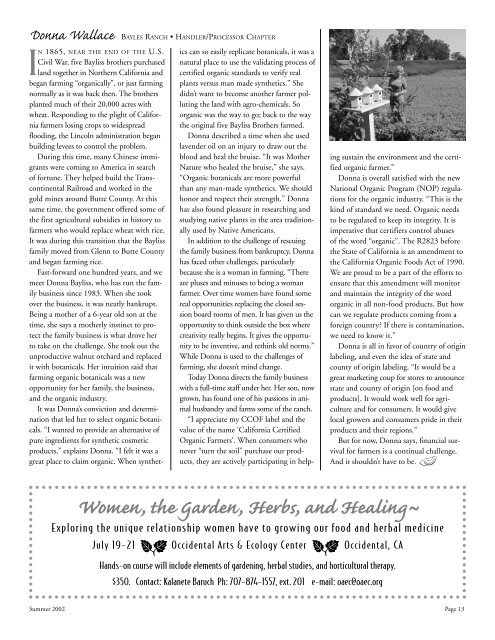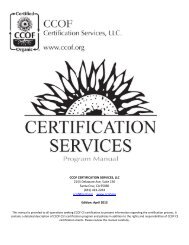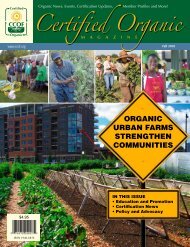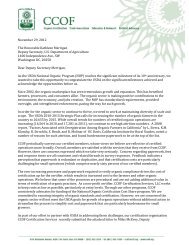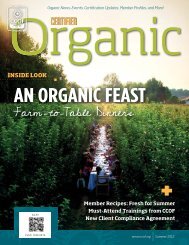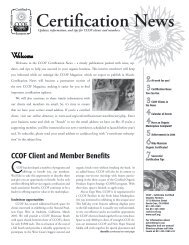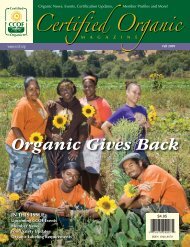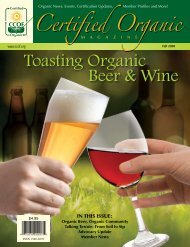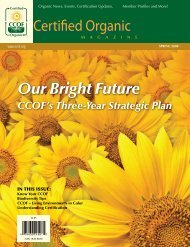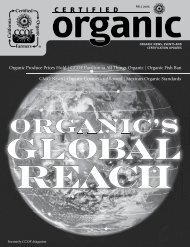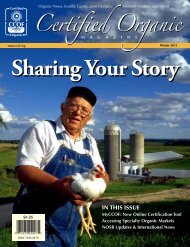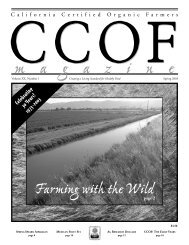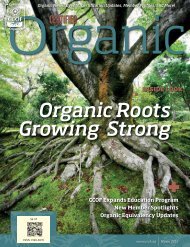Herstory: Women in Organic Agriculture - CCOF
Herstory: Women in Organic Agriculture - CCOF
Herstory: Women in Organic Agriculture - CCOF
Create successful ePaper yourself
Turn your PDF publications into a flip-book with our unique Google optimized e-Paper software.
Donna Wallace BAYLES RANCH • HANDLER/PROCESSOR CHAPTER<br />
IN 1865, NEAR THE END OF THE U.S.<br />
Civil War, five Bayliss brothers purchased<br />
land together <strong>in</strong> Northern California and<br />
began farm<strong>in</strong>g “organically”, or just farm<strong>in</strong>g<br />
normally as it was back then. The brothers<br />
planted much of their 20,000 acres with<br />
wheat. Respond<strong>in</strong>g to the plight of California<br />
farmers los<strong>in</strong>g crops to widespread<br />
flood<strong>in</strong>g, the L<strong>in</strong>coln adm<strong>in</strong>istration began<br />
build<strong>in</strong>g levees to control the problem.<br />
Dur<strong>in</strong>g this time, many Ch<strong>in</strong>ese immigrants<br />
were com<strong>in</strong>g to America <strong>in</strong> search<br />
of fortune. They helped build the Transcont<strong>in</strong>ental<br />
Railroad and worked <strong>in</strong> the<br />
gold m<strong>in</strong>es around Butte County. At this<br />
same time, the government offered some of<br />
the first agricultural subsidies <strong>in</strong> history to<br />
farmers who would replace wheat with rice.<br />
It was dur<strong>in</strong>g this transition that the Bayliss<br />
family moved from Glenn to Butte County<br />
and began farm<strong>in</strong>g rice.<br />
Fast-forward one hundred years, and we<br />
meet Donna Bayliss, who has run the family<br />
bus<strong>in</strong>ess s<strong>in</strong>ce 1983. When she took<br />
over the bus<strong>in</strong>ess, it was nearly bankrupt.<br />
Be<strong>in</strong>g a mother of a 6-year old son at the<br />
time, she says a motherly <strong>in</strong>st<strong>in</strong>ct to protect<br />
the family bus<strong>in</strong>ess is what drove her<br />
to take on the challenge. She took out the<br />
unproductive walnut orchard and replaced<br />
it with botanicals. Her <strong>in</strong>tuition said that<br />
farm<strong>in</strong>g organic botanicals was a new<br />
opportunity for her family, the bus<strong>in</strong>ess,<br />
and the organic <strong>in</strong>dustry.<br />
It was Donna’s conviction and determ<strong>in</strong>ation<br />
that led her to select organic botanicals.<br />
“I wanted to provide an alternative of<br />
pure <strong>in</strong>gredients for synthetic cosmetic<br />
products,” expla<strong>in</strong>s Donna. “I felt it was a<br />
great place to claim organic. When synthetics<br />
can so easily replicate botanicals, it was a<br />
natural place to use the validat<strong>in</strong>g process of<br />
certified organic standards to verify real<br />
plants versus man made synthetics.” She<br />
didn’t want to become another farmer pollut<strong>in</strong>g<br />
the land with agro-chemicals. So<br />
organic was the way to go; back to the way<br />
the orig<strong>in</strong>al five Bayliss Brothers farmed.<br />
Donna described a time when she used<br />
lavender oil on an <strong>in</strong>jury to draw out the<br />
blood and heal the bruise. “It was Mother<br />
Nature who healed the bruise,” she says.<br />
“<strong>Organic</strong> botanicals are more powerful<br />
than any man-made synthetics. We should<br />
honor and respect their strength.” Donna<br />
has also found pleasure <strong>in</strong> research<strong>in</strong>g and<br />
study<strong>in</strong>g native plants <strong>in</strong> the area traditionally<br />
used by Native Americans.<br />
In addition to the challenge of rescu<strong>in</strong>g<br />
the family bus<strong>in</strong>ess from bankruptcy, Donna<br />
has faced other challenges, particularly<br />
because she is a woman <strong>in</strong> farm<strong>in</strong>g. “There<br />
are pluses and m<strong>in</strong>uses to be<strong>in</strong>g a woman<br />
farmer. Over time women have found some<br />
real opportunities replac<strong>in</strong>g the closed session<br />
board rooms of men. It has given us the<br />
opportunity to th<strong>in</strong>k outside the box where<br />
creativity really beg<strong>in</strong>s. It gives the opportunity<br />
to be <strong>in</strong>ventive, and reth<strong>in</strong>k old norms.”<br />
While Donna is used to the challenges of<br />
farm<strong>in</strong>g, she doesn’t m<strong>in</strong>d change.<br />
Today Donna directs the family bus<strong>in</strong>ess<br />
with a full-time staff under her. Her son, now<br />
grown, has found one of his passions <strong>in</strong> animal<br />
husbandry and farms some of the ranch.<br />
“I appreciate my <strong>CCOF</strong> label and the<br />
value of the name ‘California Certified<br />
<strong>Organic</strong> Farmers’. When consumers who<br />
never “turn the soil” purchase our products,<br />
they are actively participat<strong>in</strong>g <strong>in</strong> help<strong>in</strong>g<br />
susta<strong>in</strong> the environment and the certified<br />
organic farmer.”<br />
Donna is overall satisfied with the new<br />
National <strong>Organic</strong> Program (NOP) regulations<br />
for the organic <strong>in</strong>dustry. “This is the<br />
k<strong>in</strong>d of standard we need. <strong>Organic</strong> needs<br />
to be regulated to keep its <strong>in</strong>tegrity. It is<br />
imperative that certifiers control abuses<br />
of the word “organic”. The R2823 before<br />
the State of California is an amendment to<br />
the California <strong>Organic</strong> Foods Act of 1990.<br />
We are proud to be a part of the efforts to<br />
ensure that this amendment will monitor<br />
and ma<strong>in</strong>ta<strong>in</strong> the <strong>in</strong>tegrity of the word<br />
organic <strong>in</strong> all non-food products. But how<br />
can we regulate products com<strong>in</strong>g from a<br />
foreign country? If there is contam<strong>in</strong>ation,<br />
we need to know it.”<br />
Donna is all <strong>in</strong> favor of country of orig<strong>in</strong><br />
label<strong>in</strong>g, and even the idea of state and<br />
county of orig<strong>in</strong> label<strong>in</strong>g. “It would be a<br />
great market<strong>in</strong>g coup for stores to announce<br />
state and county of orig<strong>in</strong> [on food and<br />
products]. It would work well for agriculture<br />
and for consumers. It would give<br />
local growers and consumers pride <strong>in</strong> their<br />
products and their regions.”<br />
But for now, Donna says, f<strong>in</strong>ancial survival<br />
for farmers is a cont<strong>in</strong>ual challenge.<br />
And it shouldn’t have to be.<br />
<strong>Women</strong>, the Garden, Herbs, and Heal<strong>in</strong>g~<br />
Explor<strong>in</strong>g the unique relationship women have to grow<strong>in</strong>g our food and herbal medic<strong>in</strong>e<br />
July 19-21 Occidental Arts & Ecology Center Occidental, CA<br />
Hands-on course will <strong>in</strong>clude elements of garden<strong>in</strong>g, herbal studies, and horticultural therapy.<br />
$350. Contact: Kalanete Baruch Ph: 707-874-1557, ext. 201 e-mail: oaec@oaec.org<br />
Summer 2002 Page 13


